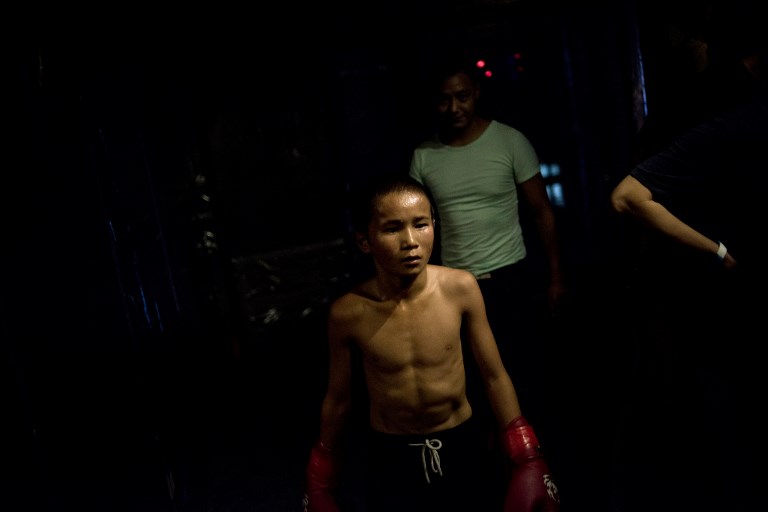‘Fighting for their fate’: Chinese kids adopted by MMA club

This picture taken June 2, 2017 shows Abieamu, 13, preparing to fight in an underground fight club in Chengdu.
Abieamu is among the kids from the Tibetan plateau who were adopted into the Enbo Fight Club in Chengdu, the capital of Sichuan province. Though most of the club’s activities are government-sanctioned, Chengdu police launched an investigation into the mixed martial arts (MMA) group in late July after a video showing two 14-year-old boys in a bruising cage fight before a roaring crowd went viral last week. / AFP PHOTO / Fred DUFOUR
The 13-year-old fighter in training starts his day at 8 a.m.
After a quick breakfast, he heads to a gym in southwest China where more than a dozen other shirtless teenage boys are kickboxing, wrestling and grappling — holding one another in full-body grips until one person yields.
Article continues after this advertisementAbieamu is among the kids from the Tibetan plateau who were adopted into the Enbo Fight Club in Chengdu, the capital of Sichuan province. Many were orphans or came from impoverished homes, and were connected to the club through the local civil affairs bureau.
Though most of the club’s activities are government-sanctioned, Chengdu police launched an investigation into the mixed martial arts (MMA) group earlier this week after a video showing two 14-year-old boys in a bruising cage fight before a roaring crowd went viral last week.
Local authorities could not be reached for comment Friday. The education department in Liangshan Yi Autonomous Prefecture told Chinese media that the underage fighters have been returned to Liangshan and may be matched with new schools.
Article continues after this advertisementA coach for the club told AFP that most of the kids have returned to the Tibetan and Qiang Autonomous Prefecture of Aba, where they are continuing their training.
En Bo, the club’s Tibetan founder, was formerly in the military, and has spent the last 18 years running amateur MMA fighting studios.
Enbo Fight Club boasts more than 200 members, with kids comprising just a small fraction.
“As long as they meet my standards, we take kids of all ethnic groups, including the Qiang, Hui, Yi and Tibetan minorities,” En Bo told AFP in June. “We have a team that manages their health and safety, as well as teachers who are responsible for their schooling.”
The kids’ housing, food and clothes are all provided by the club, En Bo said, and they receive extra “scholarships” if they win fights.
But many commentators online were alarmed by the web documentary, streamed on the site Pear Video, in which the kids’ sparring appeared to be sold as a commercial spectacle.
In the footage, two thin, prepubescent fighters are seen in an octagonal steel cage. One knocks the other down and proceeds to bash him repeatedly about the head and body as the losing fighter cowers on the mat.
Models wearing bikini tops and short jeans cheer and a man with a microphone whips up the crowd by saying the boys were “fighting for their fate.”
“These kids are tougher than your kids,” the MC says. “Their story is more touching than your kids’. And they have had it much harder than your kids.”
The video was a point of fierce debate on China’s Twitter-like Weibo platform.
“Soliciting and using minors to engage in commercial performances which are also violent, while depriving them of a salary, is illegal,” wrote one user named Chen Ming.
Others argued that without the club the boys would end up on the street and a possible life of crime.
The glaring neon lights, rowdy crowds, and scantily-clad female performers at these public fights did not faze Jihushuojie, a 12-year-old who joined the club one and half years ago.
“I’m not really scared of getting hurt,” he told AFP. “Before a fight, I feel relaxed and excited.”
China had 500,000 orphans at the end of 2015, with less than 20 percent raised by the state and only about five percent adopted, the latest-available official figures show.
The fate of the rest is unclear.